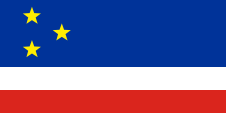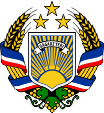Gagausien |
|
|
|
| Übersicht – Contents: | |
Diese Seite ist Teil des Projektes
Gagausien |
|
|
|
| Übersicht – Contents: | |
Flagge – Flag: |
|
 |
Nationalflagge – national flag, |
historische Flagge – historical Flag: |
|
 |
11.Jhd/cent.–13.Jhd/cent., |
 |
1990–1995, |
| Die heutige Flagge Gagausiens wurde am 31.10.1995 offiziell angenommen. Sie zeigt drei horizontale Streifen in Blau, Weiß und Rot im Verhältnis 3:1:1. Blau ist die traditionelle Farbe der Turkvölker – geht wahrscheinlich auf Timur Lenk zurück – und steht für den Himmel und Hoffnung und die Liebe zur Heimat. Das Weiß symbolisiert traditionell den Westen, den Lebensraum der Gagausen, steht aber auch für Friedfertigkeit. Das Rot steht für Mut und Ausdauer im Kampf für die Freiheit. Die drei Sterne symbolisieren Vergangenheit, Gegenwart und Zukunft. | The today's flag of Gagauzia was officially adoped on 31st of October in 1995. It shows three horizontal stripes in blue, white and red in the ratio 3:1:1. Blue is the traditional colour of the Turkish nations – has its roots probably at Timur Lenk – and stands for the heaven and the hope and the allegiance to the homeland. The white symbolizes traditionally the west – the environment of the Gagauzians – but stands for peaceableness too. The red stands for courage and endurance in the struggle for the freedom. The three stars symbolize past, presence und future. | ||
| Die vorherige, inoffizielle Flagge von Gagausien ging auf die Flagge des Kumanischen Reiches (1061–1240) zurück, und zeigte den Kopf eines Wolfs. Es waren auch andere Varianten der Flagge bekannt. |
The previous unofficial flag of Gagauzia had its roots in the flag of the
Kumanian Empire (1061–1240) and showed the head of a wolf. There were known
other variants of the flag. |
||
|
Quelle/Source:
Wikipedia (DE),
Flags of the World | |||
| Wappen – Coat of arms: | |
 |
Wappen von Gagausien – coat of arms of Gagauzia, Quelle/Source, nach by: Wikipedia (DE) |
| Landkarte – Map: |
Lage innerhalb Moldawiens – Position within Moldova: |
|
|
| Zahlen und Fakten – Numbers and Facts: | |
|
|
|
|
|
|
|
|
|
|
|
|
|
|
|
|
|
|
| Quelle/Source: Wikipedia (DE) | |
|
6. Jhd. · das Gebiet des heutigen Gagausien wird von Slawen
besiedelt ca. 1050 · Eindringen der Kumanen (auch Kun, Kiptschak oder Polowzer genannt, die Vorfahren der heutigen Gagausen) 1061–1240 · das Gebiet des heutigen Gagausien gehört zum Kumanischen Reich 1240 · das Kumanische Reich wird von den Mongolen zerstört, nach Abzug der Mongolen (etwa 1280) entsteht zwischen den Karpaten und dem Dnestr das Fürstentum Moldau 1455 · das Fürstentum Moldau wird dem Osmanischen Reich tributpflichtig 1484 · der Süden von Moldau, das Gebiet der Gagausen, wird vom Osmanischen Reich als Provinz Butscha annektiert 1511 · das Fürstentum Moldau wird zu einem osmanischen Vasallenstaat 1806 · Russland besetzt im Krimkrieg den osmanischen Vasallenstaat Moldau und das Gebiet Butscha 1812 · Russland teilt Moldau und Butscha: die Gebiete zwischen Prut und Dnestr werden als Bessarabien (später Moldawien genannt) von Russland anektiert, und damit auch das Gebiet der Gagausen im Süden des Landes 1856 · Gagausien kommt unter moldauisch-rumänische Herrschaft 1878 · Gagausien wird wieder russisch 1918 · Rumänien annektiert Bessarabien (und damit Gagausien) 1924 · auf Ukrainischem Gebiet, östlich des Dnestr, wird die Moldawische Autonome Sozialistische Sowjetrepublik gegründet (Transnistrien) 1940 · Rumänien tritt Bessarabien (und damit Gagausien) an die UdSSR ab, Vereinigung Bessarabiens und der Moldauischen ASSR zur Moldauischen SSR (heutiges Moldawien) 1941–1945 · Annexion Moldawiens (und damit Gagausiens) durch Rumänien 1945 · Moldawien (und damit Gagausien) kommt wieder als Moldawische SSR zur UdSSR 1980 · Beginn des Freiheitskampfes der Gagausen 1989 · die Gagausen werden durch Sprachgesetze in Moldawien diskriminiert 1990 · Ausrufung der unabhängigen Republik Gagausien 1994 · Anerkennung der Republik Gagausien als autonome Republik innerhalb Moldawiens 1995 · Wahlen zur Nationalversammlung von Gagausien, offizielles Ende des fünfjährigen Konfliktes zwischen Gagausien und Moldawien 2014 · Referendum in Gagausien, 70 % Beteiligung, Ergebnis: 98,4 % für engere Beziehungen mit Russland, 97,2 % gegen Annäherung an die EU 2014 · der moldauische Ex-Präsident fordert ein Referendum in Moldawien über die Abschaffung der Autonomie Gagausiens |
|
6th century · the region of the today's Gagauzia gets settled by
Slavs ca. 1050 · invading of the Kumanes (also named Kun, Kiptshak or Polowzians, the forefathers of the today's Gagauz people) 1061–1240 · the region of the today's Gagauzia belongs to the Kumanian Empire 1240 · the Kumanian Empire gets destroyed by the Mongolians, after the withdrawal of the Mongolians (ca. 1280) arises between the Carpate mountains and the river Dnestr the Principality of Moldau 1455 · the Principality of Moldau comes toward the Ottoman Empire in tribute duty 1484 · the south of Moldau, the area of the Gagauz people, gets annexed by the Ottoman Empire as province of Butsha 1511 · the Principality of Moldau becomes to an Ottoman vassal state 1806 · Russia occupies in the crimean war the Ottoman vassal state of Moldau and the Butsha area 1812 · Russia divides Moldau and Butsha: the territories between the river Prut and the river Dnestr become annexed as Bessarabia (later named Moldova) by Russia and therewith also the region of the Gagauz people in the south of the country 1856 · Gagauzia come under Moldovan-Romanian control 1878 · Gagauzia gets Russian again 1918 · Romania annexes Bessarabia (and therewith Gagauzia) 1924 · on Ukrainian territory, eastern the river Dnestr, gets established the Moldovan Autonomous Socialistic Soviet Republic (Transnistria) 1940 · Romania cedes Bessarabia (and therewith Gagauzia) to the USSR, unification of Bessarabia and the Moldovan ASSR to the Moldovan SSR (today's Moldova) 1941–1945 · annexation of Moldova (and therewith of Gagauzia) by Romania 1945 · Moldova (and therewith Gagauzia) comes again as Moldovan SSR to the USSR 1980 · start of the Gagauzian freedom fight 1989 · the Gagauz people gets discriminated by language laws in Moldova 1990 · proclamation of the independent Republic of Gagauzia 1994 · recognition of the Republic of Gagauzia as autonomous republic within Moldova 1995 · elections to the national assembly of Gagauzia, official end of the five years enduring conflict between Gagauzia and Moldova 2014 · Referendum in Gagauzia, 70% turnout, result: 98.4% for closer relations with Russia, 97.2% against rapprochement with the EU 2014 · the Moldovan ex-president calls for a referendum in Moldova on the abolition of Gagauzia's autonomy |
| Quelle/Source: Wikipedia (DE), Atlas zur Geschichte, Weltgeschichte |
| Der Name des Landes "Gagausien" geht auf das hier lebende Volk der Gagausen zurück. Die Vorfahren der Gagausen, die Kumanen (auch Kun, Kiptschak oder Polowzer genannt), wanderten im 11. Jahrhundert in der Region ein. Das Wort "Gagauz" geht auf das türkische Wort "Gökoğuz" zurück. "Gök" heißt Himmel "Oğuz" heißt "Oghuse". Oghusen ist eine Bezeichnung für tatarische Stämme. Nach der Mongoleninvasion wurde für diese Stämme die Bezeichnung "Türkmen" verwendet. | The name
of the country "Gagauzia" goes back to the here living people of the Gagauz.
The ancestors of the Gagauz who had been called Cumans (also Kun, Kipchak or
Polowzians), migrated in the region in the 11th century. The word "Gagauz" goes back to the Turkish word "Gökoğuz". "Gök" means heaven "Oğuz" means "Oghuz". Oghuz is a name for Tatar tribes. After the Mongol invasion, the term "Türkmen" was used for them. |
| Quelle/Source: Wikipedia (DE), Die Völker der Erde | |